Corporate Accounting Report: Analysis of Surfstitch Ltd's Financials
VerifiedAdded on 2020/02/19
|12
|2984
|306
Report
AI Summary
This report provides a comprehensive financial analysis of Surfstitch Ltd, examining its financial predicament, including the impact of key events like the exit of a founder and rising expenses on its profitability. The report identifies the company's goodwill, investment in subsidiaries, and cash positions in 2015, along with impairment costs, selling & distribution, and administrative expenses in 2016. It then offers a recommendation on whether to buy, hold, or sell Surfstitch Ltd shares based on the financial data. The second part of the report discusses the necessity and effectiveness of a continuous reporting regime for disclosure entities, exploring its role in reducing unethical practices and ensuring accurate information for investors. The report references relevant literature and highlights the importance of continuous disclosure in maintaining market integrity and investor confidence, especially in the context of the ASX.
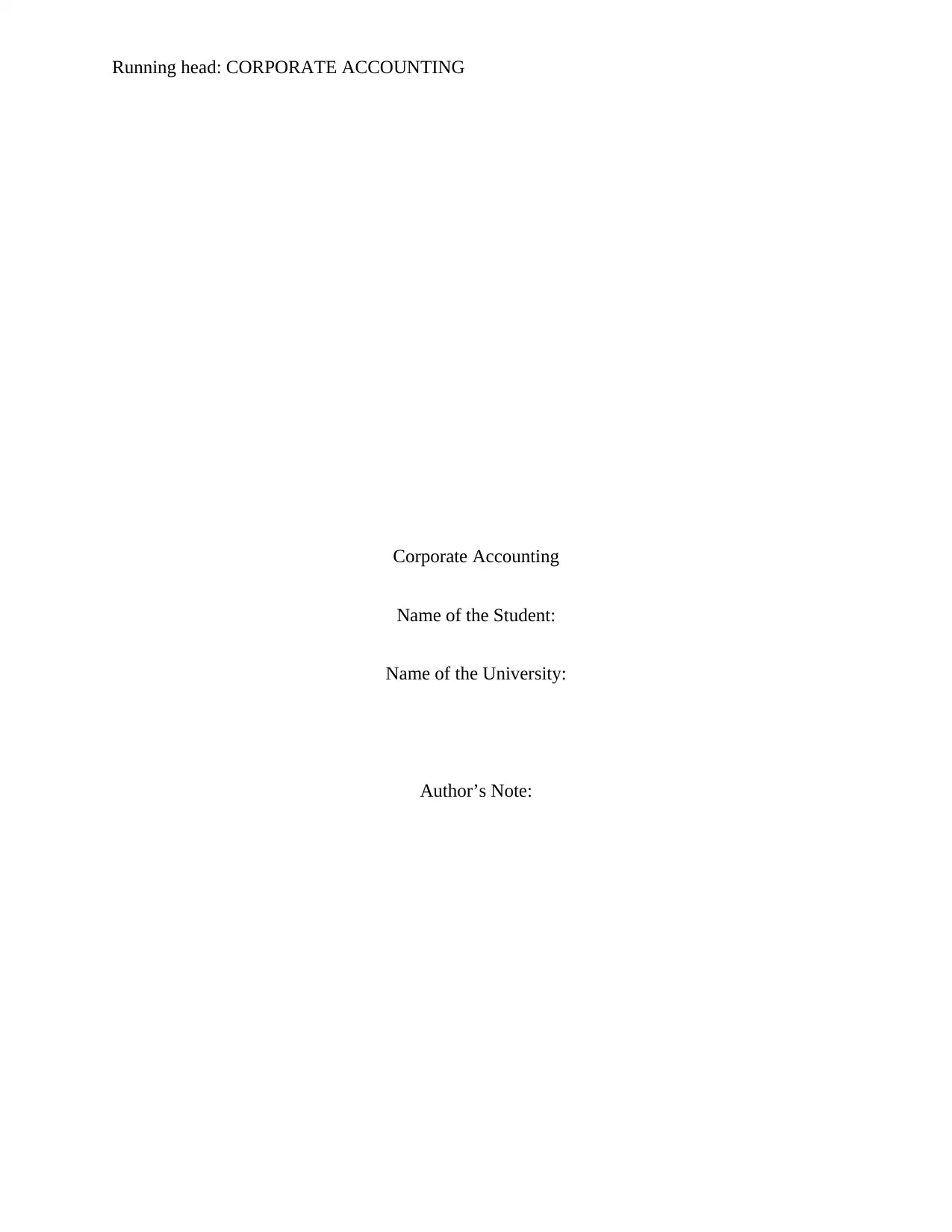
Running head: CORPORATE ACCOUNTING
Corporate Accounting
Name of the Student:
Name of the University:
Author’s Note:
Corporate Accounting
Name of the Student:
Name of the University:
Author’s Note:
Paraphrase This Document
Need a fresh take? Get an instant paraphrase of this document with our AI Paraphraser
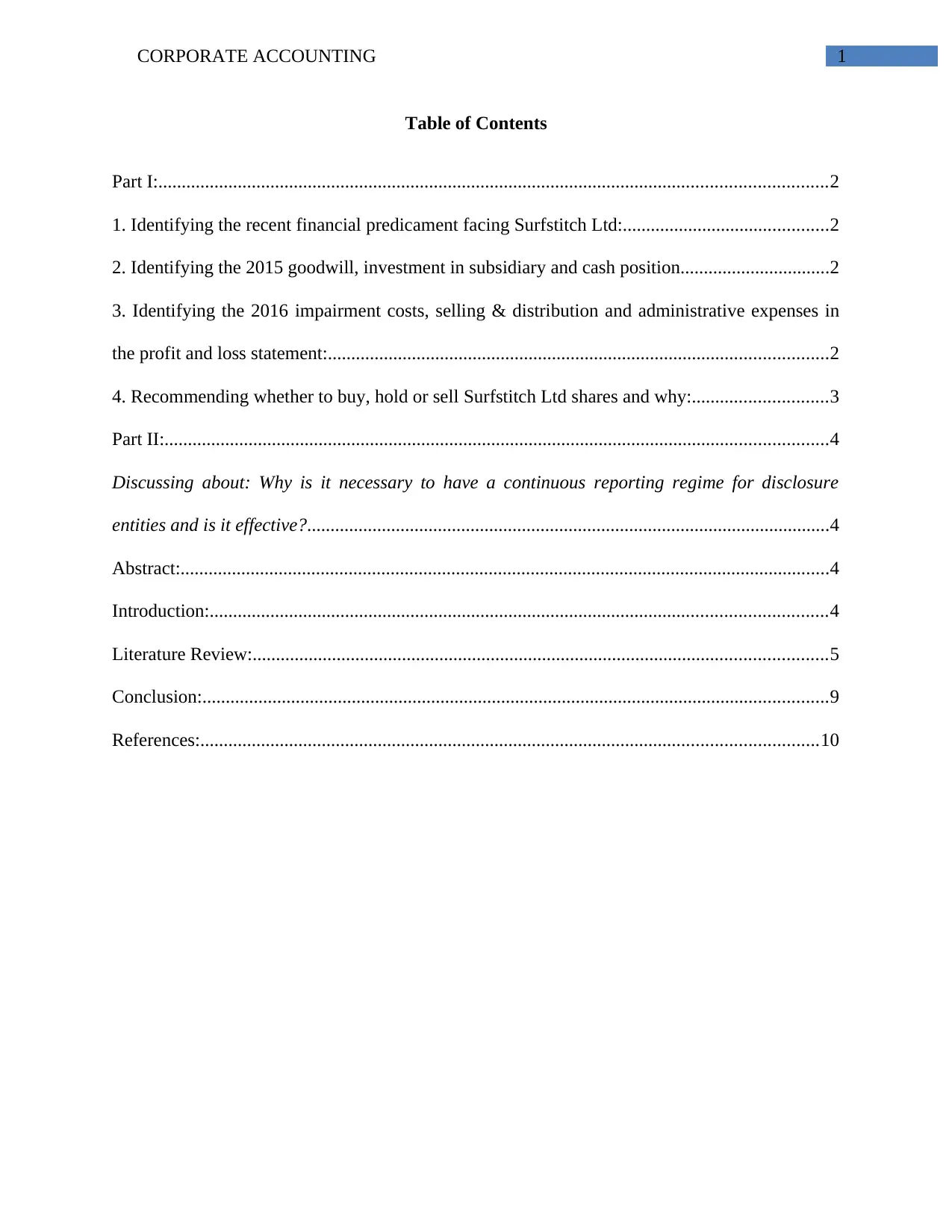
CORPORATE ACCOUNTING 1
Table of Contents
Part I:...............................................................................................................................................2
1. Identifying the recent financial predicament facing Surfstitch Ltd:............................................2
2. Identifying the 2015 goodwill, investment in subsidiary and cash position................................2
3. Identifying the 2016 impairment costs, selling & distribution and administrative expenses in
the profit and loss statement:...........................................................................................................2
4. Recommending whether to buy, hold or sell Surfstitch Ltd shares and why:.............................3
Part II:..............................................................................................................................................4
Discussing about: Why is it necessary to have a continuous reporting regime for disclosure
entities and is it effective?................................................................................................................4
Abstract:...........................................................................................................................................4
Introduction:....................................................................................................................................4
Literature Review:...........................................................................................................................5
Conclusion:......................................................................................................................................9
References:....................................................................................................................................10
Table of Contents
Part I:...............................................................................................................................................2
1. Identifying the recent financial predicament facing Surfstitch Ltd:............................................2
2. Identifying the 2015 goodwill, investment in subsidiary and cash position................................2
3. Identifying the 2016 impairment costs, selling & distribution and administrative expenses in
the profit and loss statement:...........................................................................................................2
4. Recommending whether to buy, hold or sell Surfstitch Ltd shares and why:.............................3
Part II:..............................................................................................................................................4
Discussing about: Why is it necessary to have a continuous reporting regime for disclosure
entities and is it effective?................................................................................................................4
Abstract:...........................................................................................................................................4
Introduction:....................................................................................................................................4
Literature Review:...........................................................................................................................5
Conclusion:......................................................................................................................................9
References:....................................................................................................................................10
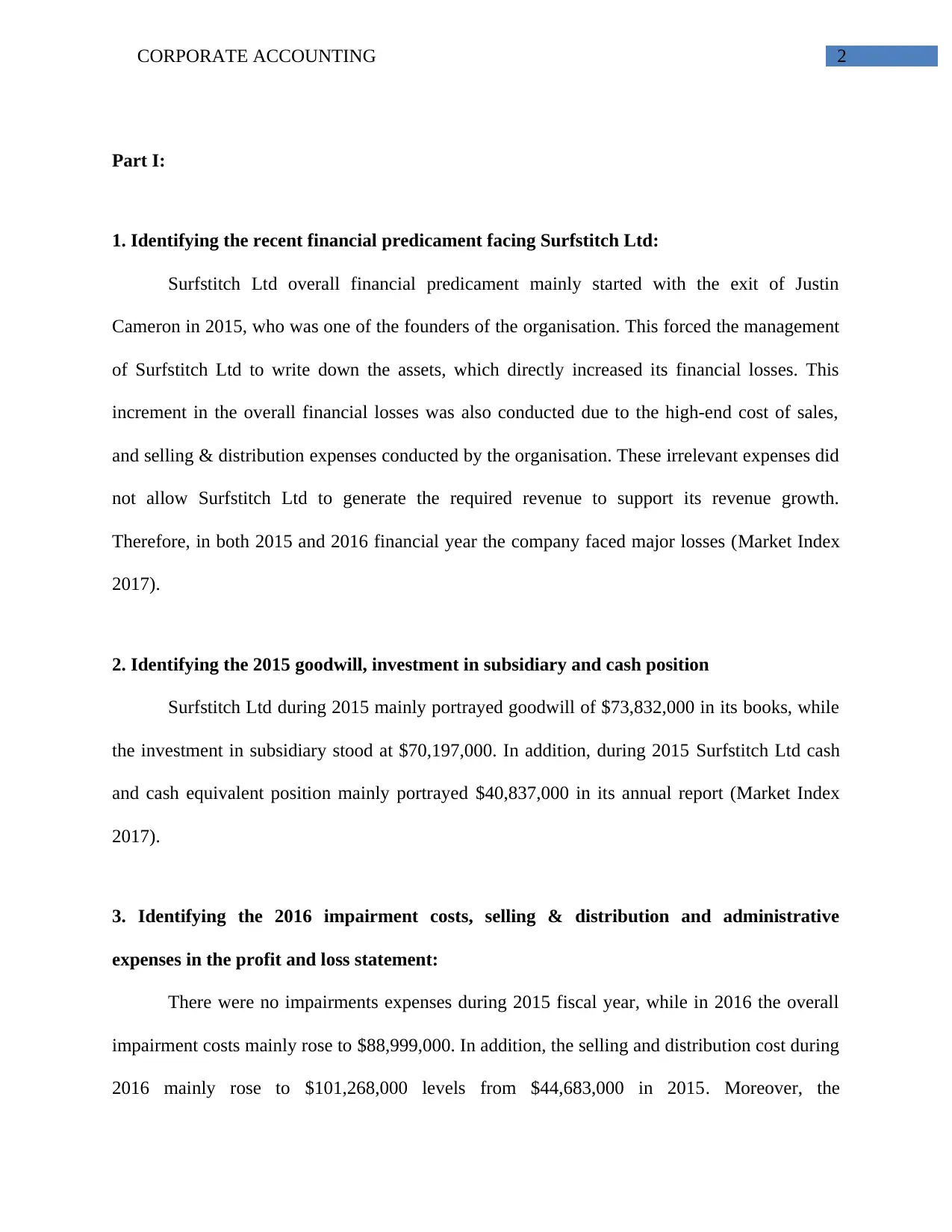
CORPORATE ACCOUNTING 2
Part I:
1. Identifying the recent financial predicament facing Surfstitch Ltd:
Surfstitch Ltd overall financial predicament mainly started with the exit of Justin
Cameron in 2015, who was one of the founders of the organisation. This forced the management
of Surfstitch Ltd to write down the assets, which directly increased its financial losses. This
increment in the overall financial losses was also conducted due to the high-end cost of sales,
and selling & distribution expenses conducted by the organisation. These irrelevant expenses did
not allow Surfstitch Ltd to generate the required revenue to support its revenue growth.
Therefore, in both 2015 and 2016 financial year the company faced major losses (Market Index
2017).
2. Identifying the 2015 goodwill, investment in subsidiary and cash position
Surfstitch Ltd during 2015 mainly portrayed goodwill of $73,832,000 in its books, while
the investment in subsidiary stood at $70,197,000. In addition, during 2015 Surfstitch Ltd cash
and cash equivalent position mainly portrayed $40,837,000 in its annual report (Market Index
2017).
3. Identifying the 2016 impairment costs, selling & distribution and administrative
expenses in the profit and loss statement:
There were no impairments expenses during 2015 fiscal year, while in 2016 the overall
impairment costs mainly rose to $88,999,000. In addition, the selling and distribution cost during
2016 mainly rose to $101,268,000 levels from $44,683,000 in 2015. Moreover, the
Part I:
1. Identifying the recent financial predicament facing Surfstitch Ltd:
Surfstitch Ltd overall financial predicament mainly started with the exit of Justin
Cameron in 2015, who was one of the founders of the organisation. This forced the management
of Surfstitch Ltd to write down the assets, which directly increased its financial losses. This
increment in the overall financial losses was also conducted due to the high-end cost of sales,
and selling & distribution expenses conducted by the organisation. These irrelevant expenses did
not allow Surfstitch Ltd to generate the required revenue to support its revenue growth.
Therefore, in both 2015 and 2016 financial year the company faced major losses (Market Index
2017).
2. Identifying the 2015 goodwill, investment in subsidiary and cash position
Surfstitch Ltd during 2015 mainly portrayed goodwill of $73,832,000 in its books, while
the investment in subsidiary stood at $70,197,000. In addition, during 2015 Surfstitch Ltd cash
and cash equivalent position mainly portrayed $40,837,000 in its annual report (Market Index
2017).
3. Identifying the 2016 impairment costs, selling & distribution and administrative
expenses in the profit and loss statement:
There were no impairments expenses during 2015 fiscal year, while in 2016 the overall
impairment costs mainly rose to $88,999,000. In addition, the selling and distribution cost during
2016 mainly rose to $101,268,000 levels from $44,683,000 in 2015. Moreover, the
⊘ This is a preview!⊘
Do you want full access?
Subscribe today to unlock all pages.

Trusted by 1+ million students worldwide
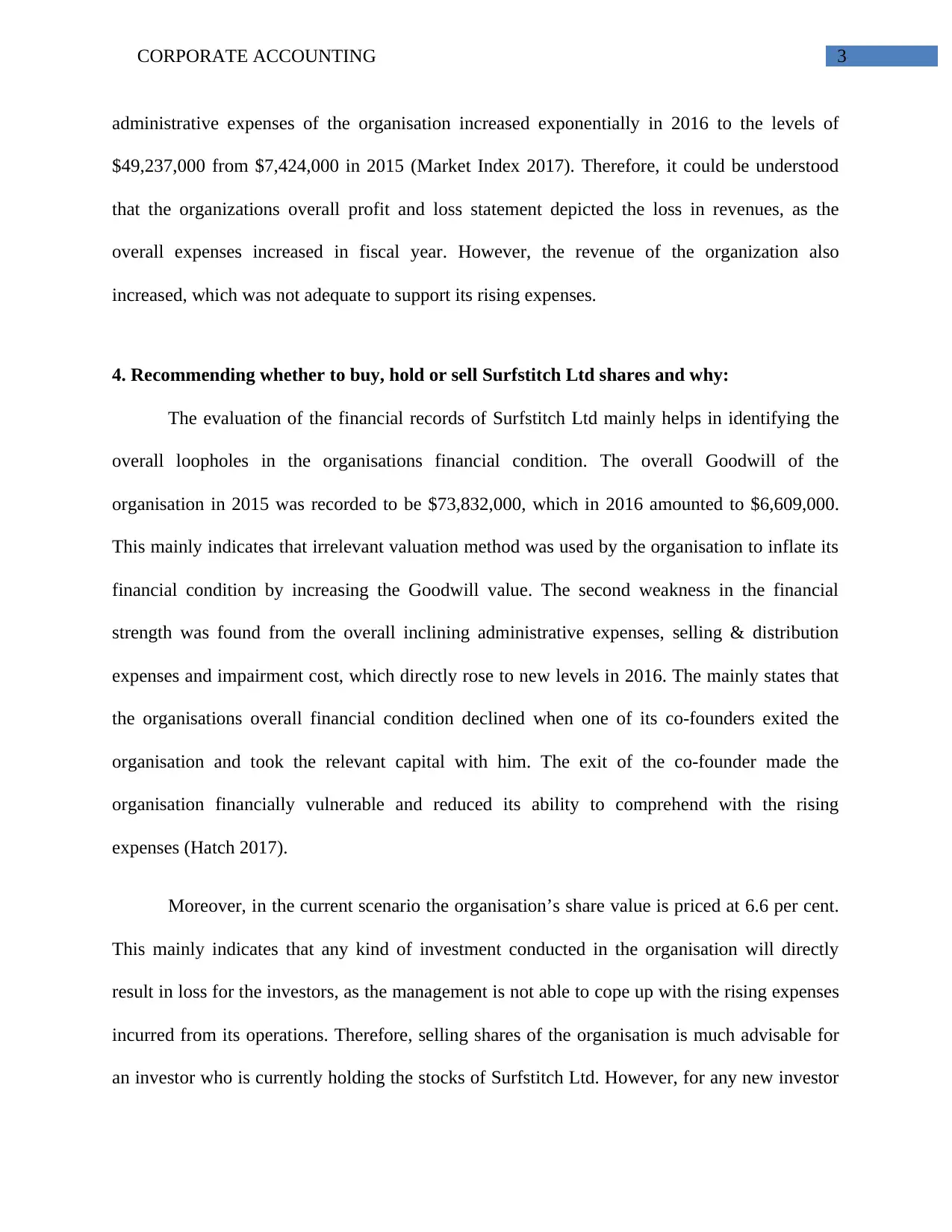
CORPORATE ACCOUNTING 3
administrative expenses of the organisation increased exponentially in 2016 to the levels of
$49,237,000 from $7,424,000 in 2015 (Market Index 2017). Therefore, it could be understood
that the organizations overall profit and loss statement depicted the loss in revenues, as the
overall expenses increased in fiscal year. However, the revenue of the organization also
increased, which was not adequate to support its rising expenses.
4. Recommending whether to buy, hold or sell Surfstitch Ltd shares and why:
The evaluation of the financial records of Surfstitch Ltd mainly helps in identifying the
overall loopholes in the organisations financial condition. The overall Goodwill of the
organisation in 2015 was recorded to be $73,832,000, which in 2016 amounted to $6,609,000.
This mainly indicates that irrelevant valuation method was used by the organisation to inflate its
financial condition by increasing the Goodwill value. The second weakness in the financial
strength was found from the overall inclining administrative expenses, selling & distribution
expenses and impairment cost, which directly rose to new levels in 2016. The mainly states that
the organisations overall financial condition declined when one of its co-founders exited the
organisation and took the relevant capital with him. The exit of the co-founder made the
organisation financially vulnerable and reduced its ability to comprehend with the rising
expenses (Hatch 2017).
Moreover, in the current scenario the organisation’s share value is priced at 6.6 per cent.
This mainly indicates that any kind of investment conducted in the organisation will directly
result in loss for the investors, as the management is not able to cope up with the rising expenses
incurred from its operations. Therefore, selling shares of the organisation is much advisable for
an investor who is currently holding the stocks of Surfstitch Ltd. However, for any new investor
administrative expenses of the organisation increased exponentially in 2016 to the levels of
$49,237,000 from $7,424,000 in 2015 (Market Index 2017). Therefore, it could be understood
that the organizations overall profit and loss statement depicted the loss in revenues, as the
overall expenses increased in fiscal year. However, the revenue of the organization also
increased, which was not adequate to support its rising expenses.
4. Recommending whether to buy, hold or sell Surfstitch Ltd shares and why:
The evaluation of the financial records of Surfstitch Ltd mainly helps in identifying the
overall loopholes in the organisations financial condition. The overall Goodwill of the
organisation in 2015 was recorded to be $73,832,000, which in 2016 amounted to $6,609,000.
This mainly indicates that irrelevant valuation method was used by the organisation to inflate its
financial condition by increasing the Goodwill value. The second weakness in the financial
strength was found from the overall inclining administrative expenses, selling & distribution
expenses and impairment cost, which directly rose to new levels in 2016. The mainly states that
the organisations overall financial condition declined when one of its co-founders exited the
organisation and took the relevant capital with him. The exit of the co-founder made the
organisation financially vulnerable and reduced its ability to comprehend with the rising
expenses (Hatch 2017).
Moreover, in the current scenario the organisation’s share value is priced at 6.6 per cent.
This mainly indicates that any kind of investment conducted in the organisation will directly
result in loss for the investors, as the management is not able to cope up with the rising expenses
incurred from its operations. Therefore, selling shares of the organisation is much advisable for
an investor who is currently holding the stocks of Surfstitch Ltd. However, for any new investor
Paraphrase This Document
Need a fresh take? Get an instant paraphrase of this document with our AI Paraphraser
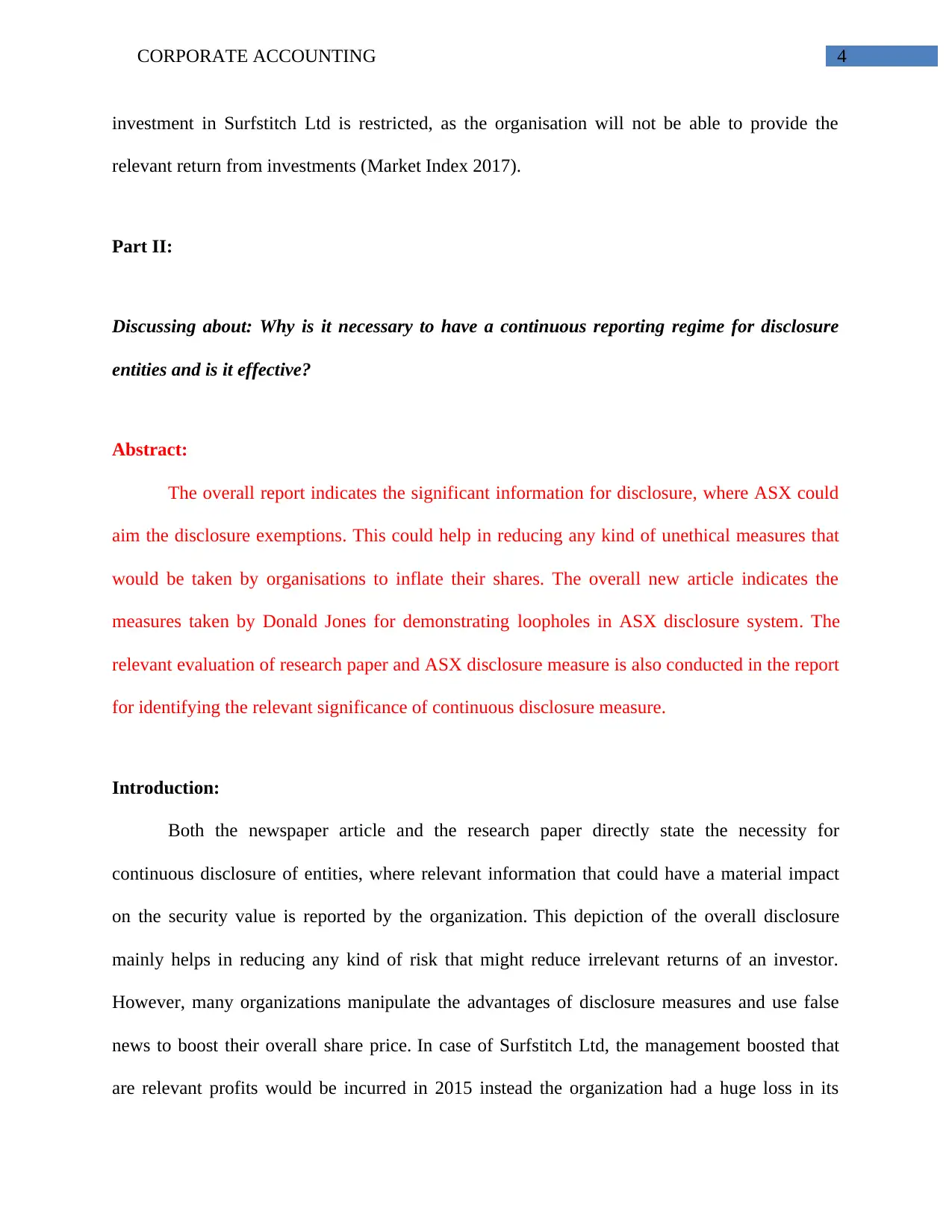
CORPORATE ACCOUNTING 4
investment in Surfstitch Ltd is restricted, as the organisation will not be able to provide the
relevant return from investments (Market Index 2017).
Part II:
Discussing about: Why is it necessary to have a continuous reporting regime for disclosure
entities and is it effective?
Abstract:
The overall report indicates the significant information for disclosure, where ASX could
aim the disclosure exemptions. This could help in reducing any kind of unethical measures that
would be taken by organisations to inflate their shares. The overall new article indicates the
measures taken by Donald Jones for demonstrating loopholes in ASX disclosure system. The
relevant evaluation of research paper and ASX disclosure measure is also conducted in the report
for identifying the relevant significance of continuous disclosure measure.
Introduction:
Both the newspaper article and the research paper directly state the necessity for
continuous disclosure of entities, where relevant information that could have a material impact
on the security value is reported by the organization. This depiction of the overall disclosure
mainly helps in reducing any kind of risk that might reduce irrelevant returns of an investor.
However, many organizations manipulate the advantages of disclosure measures and use false
news to boost their overall share price. In case of Surfstitch Ltd, the management boosted that
are relevant profits would be incurred in 2015 instead the organization had a huge loss in its
investment in Surfstitch Ltd is restricted, as the organisation will not be able to provide the
relevant return from investments (Market Index 2017).
Part II:
Discussing about: Why is it necessary to have a continuous reporting regime for disclosure
entities and is it effective?
Abstract:
The overall report indicates the significant information for disclosure, where ASX could
aim the disclosure exemptions. This could help in reducing any kind of unethical measures that
would be taken by organisations to inflate their shares. The overall new article indicates the
measures taken by Donald Jones for demonstrating loopholes in ASX disclosure system. The
relevant evaluation of research paper and ASX disclosure measure is also conducted in the report
for identifying the relevant significance of continuous disclosure measure.
Introduction:
Both the newspaper article and the research paper directly state the necessity for
continuous disclosure of entities, where relevant information that could have a material impact
on the security value is reported by the organization. This depiction of the overall disclosure
mainly helps in reducing any kind of risk that might reduce irrelevant returns of an investor.
However, many organizations manipulate the advantages of disclosure measures and use false
news to boost their overall share price. In case of Surfstitch Ltd, the management boosted that
are relevant profits would be incurred in 2015 instead the organization had a huge loss in its
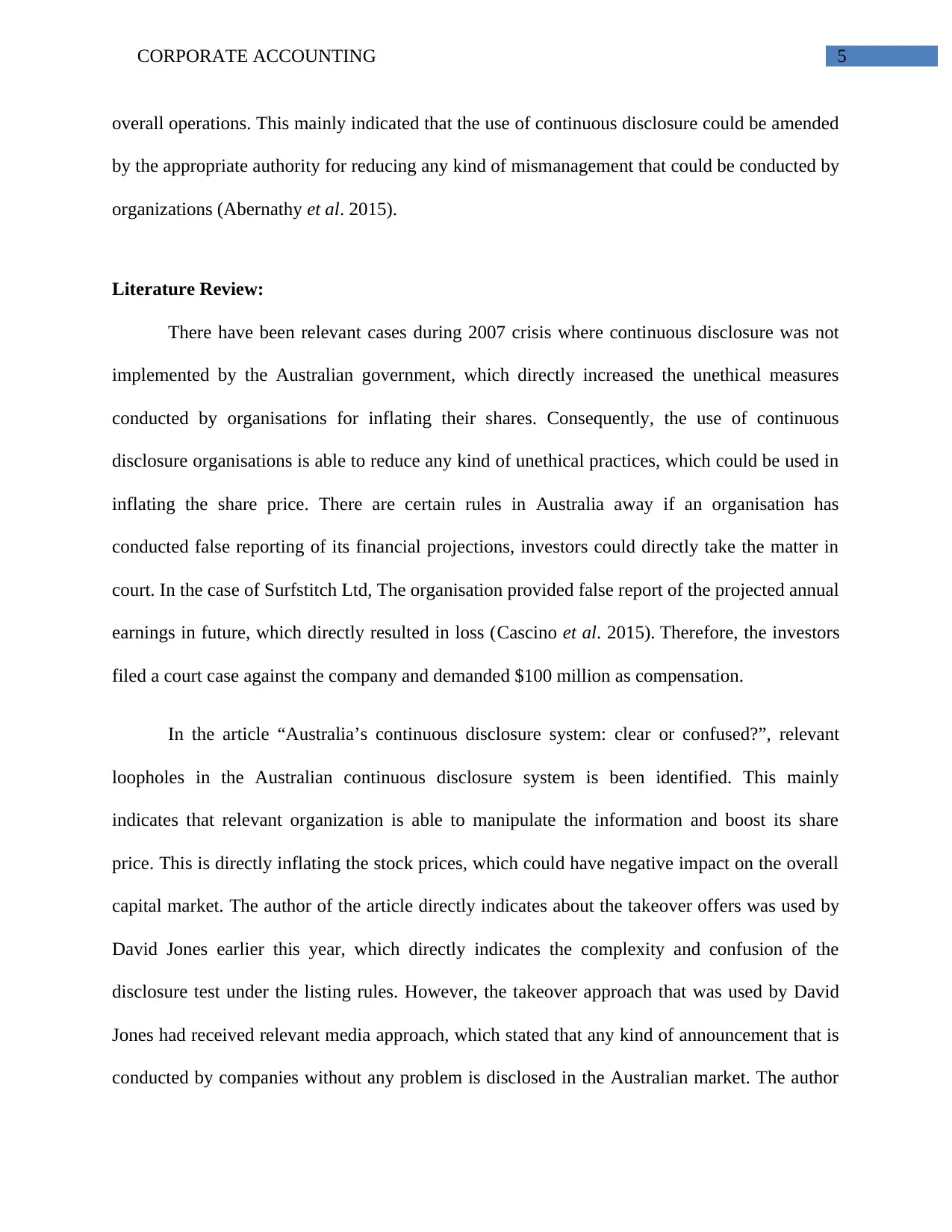
CORPORATE ACCOUNTING 5
overall operations. This mainly indicated that the use of continuous disclosure could be amended
by the appropriate authority for reducing any kind of mismanagement that could be conducted by
organizations (Abernathy et al. 2015).
Literature Review:
There have been relevant cases during 2007 crisis where continuous disclosure was not
implemented by the Australian government, which directly increased the unethical measures
conducted by organisations for inflating their shares. Consequently, the use of continuous
disclosure organisations is able to reduce any kind of unethical practices, which could be used in
inflating the share price. There are certain rules in Australia away if an organisation has
conducted false reporting of its financial projections, investors could directly take the matter in
court. In the case of Surfstitch Ltd, The organisation provided false report of the projected annual
earnings in future, which directly resulted in loss (Cascino et al. 2015). Therefore, the investors
filed a court case against the company and demanded $100 million as compensation.
In the article “Australia’s continuous disclosure system: clear or confused?”, relevant
loopholes in the Australian continuous disclosure system is been identified. This mainly
indicates that relevant organization is able to manipulate the information and boost its share
price. This is directly inflating the stock prices, which could have negative impact on the overall
capital market. The author of the article directly indicates about the takeover offers was used by
David Jones earlier this year, which directly indicates the complexity and confusion of the
disclosure test under the listing rules. However, the takeover approach that was used by David
Jones had received relevant media approach, which stated that any kind of announcement that is
conducted by companies without any problem is disclosed in the Australian market. The author
overall operations. This mainly indicated that the use of continuous disclosure could be amended
by the appropriate authority for reducing any kind of mismanagement that could be conducted by
organizations (Abernathy et al. 2015).
Literature Review:
There have been relevant cases during 2007 crisis where continuous disclosure was not
implemented by the Australian government, which directly increased the unethical measures
conducted by organisations for inflating their shares. Consequently, the use of continuous
disclosure organisations is able to reduce any kind of unethical practices, which could be used in
inflating the share price. There are certain rules in Australia away if an organisation has
conducted false reporting of its financial projections, investors could directly take the matter in
court. In the case of Surfstitch Ltd, The organisation provided false report of the projected annual
earnings in future, which directly resulted in loss (Cascino et al. 2015). Therefore, the investors
filed a court case against the company and demanded $100 million as compensation.
In the article “Australia’s continuous disclosure system: clear or confused?”, relevant
loopholes in the Australian continuous disclosure system is been identified. This mainly
indicates that relevant organization is able to manipulate the information and boost its share
price. This is directly inflating the stock prices, which could have negative impact on the overall
capital market. The author of the article directly indicates about the takeover offers was used by
David Jones earlier this year, which directly indicates the complexity and confusion of the
disclosure test under the listing rules. However, the takeover approach that was used by David
Jones had received relevant media approach, which stated that any kind of announcement that is
conducted by companies without any problem is disclosed in the Australian market. The author
⊘ This is a preview!⊘
Do you want full access?
Subscribe today to unlock all pages.

Trusted by 1+ million students worldwide
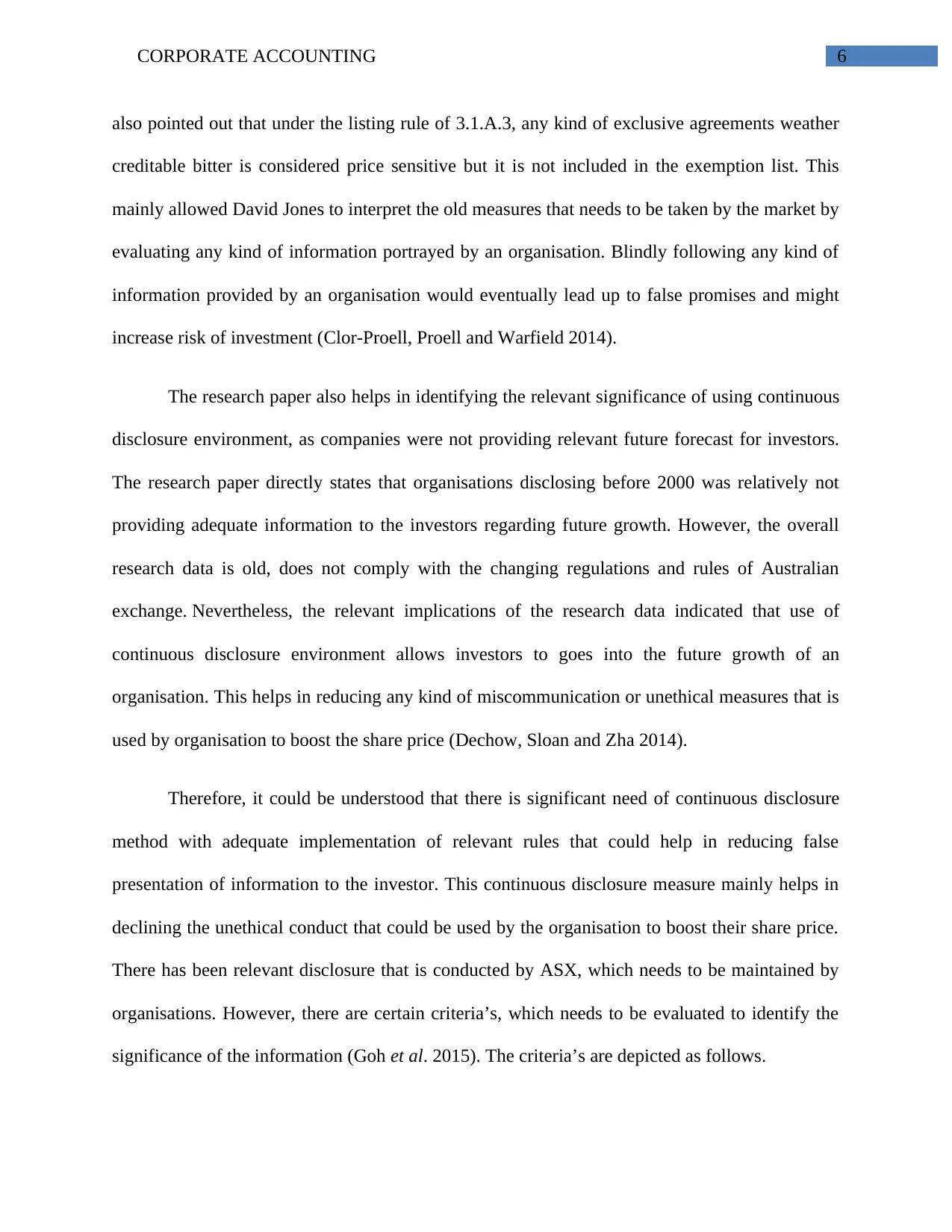
CORPORATE ACCOUNTING 6
also pointed out that under the listing rule of 3.1.A.3, any kind of exclusive agreements weather
creditable bitter is considered price sensitive but it is not included in the exemption list. This
mainly allowed David Jones to interpret the old measures that needs to be taken by the market by
evaluating any kind of information portrayed by an organisation. Blindly following any kind of
information provided by an organisation would eventually lead up to false promises and might
increase risk of investment (Clor‐Proell, Proell and Warfield 2014).
The research paper also helps in identifying the relevant significance of using continuous
disclosure environment, as companies were not providing relevant future forecast for investors.
The research paper directly states that organisations disclosing before 2000 was relatively not
providing adequate information to the investors regarding future growth. However, the overall
research data is old, does not comply with the changing regulations and rules of Australian
exchange. Nevertheless, the relevant implications of the research data indicated that use of
continuous disclosure environment allows investors to goes into the future growth of an
organisation. This helps in reducing any kind of miscommunication or unethical measures that is
used by organisation to boost the share price (Dechow, Sloan and Zha 2014).
Therefore, it could be understood that there is significant need of continuous disclosure
method with adequate implementation of relevant rules that could help in reducing false
presentation of information to the investor. This continuous disclosure measure mainly helps in
declining the unethical conduct that could be used by the organisation to boost their share price.
There has been relevant disclosure that is conducted by ASX, which needs to be maintained by
organisations. However, there are certain criteria’s, which needs to be evaluated to identify the
significance of the information (Goh et al. 2015). The criteria’s are depicted as follows.
also pointed out that under the listing rule of 3.1.A.3, any kind of exclusive agreements weather
creditable bitter is considered price sensitive but it is not included in the exemption list. This
mainly allowed David Jones to interpret the old measures that needs to be taken by the market by
evaluating any kind of information portrayed by an organisation. Blindly following any kind of
information provided by an organisation would eventually lead up to false promises and might
increase risk of investment (Clor‐Proell, Proell and Warfield 2014).
The research paper also helps in identifying the relevant significance of using continuous
disclosure environment, as companies were not providing relevant future forecast for investors.
The research paper directly states that organisations disclosing before 2000 was relatively not
providing adequate information to the investors regarding future growth. However, the overall
research data is old, does not comply with the changing regulations and rules of Australian
exchange. Nevertheless, the relevant implications of the research data indicated that use of
continuous disclosure environment allows investors to goes into the future growth of an
organisation. This helps in reducing any kind of miscommunication or unethical measures that is
used by organisation to boost the share price (Dechow, Sloan and Zha 2014).
Therefore, it could be understood that there is significant need of continuous disclosure
method with adequate implementation of relevant rules that could help in reducing false
presentation of information to the investor. This continuous disclosure measure mainly helps in
declining the unethical conduct that could be used by the organisation to boost their share price.
There has been relevant disclosure that is conducted by ASX, which needs to be maintained by
organisations. However, there are certain criteria’s, which needs to be evaluated to identify the
significance of the information (Goh et al. 2015). The criteria’s are depicted as follows.
Paraphrase This Document
Need a fresh take? Get an instant paraphrase of this document with our AI Paraphraser
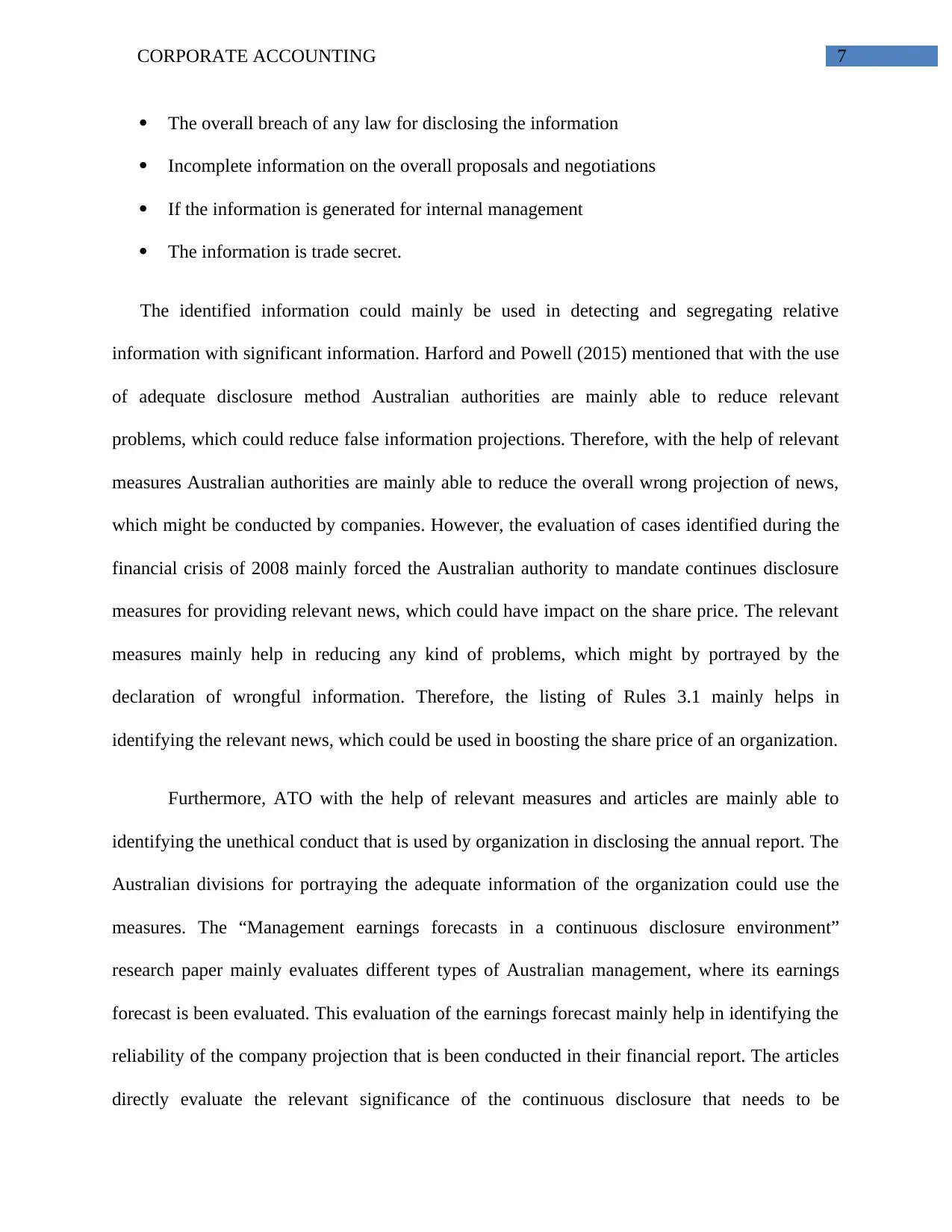
CORPORATE ACCOUNTING 7
The overall breach of any law for disclosing the information
Incomplete information on the overall proposals and negotiations
If the information is generated for internal management
The information is trade secret.
The identified information could mainly be used in detecting and segregating relative
information with significant information. Harford and Powell (2015) mentioned that with the use
of adequate disclosure method Australian authorities are mainly able to reduce relevant
problems, which could reduce false information projections. Therefore, with the help of relevant
measures Australian authorities are mainly able to reduce the overall wrong projection of news,
which might be conducted by companies. However, the evaluation of cases identified during the
financial crisis of 2008 mainly forced the Australian authority to mandate continues disclosure
measures for providing relevant news, which could have impact on the share price. The relevant
measures mainly help in reducing any kind of problems, which might by portrayed by the
declaration of wrongful information. Therefore, the listing of Rules 3.1 mainly helps in
identifying the relevant news, which could be used in boosting the share price of an organization.
Furthermore, ATO with the help of relevant measures and articles are mainly able to
identifying the unethical conduct that is used by organization in disclosing the annual report. The
Australian divisions for portraying the adequate information of the organization could use the
measures. The “Management earnings forecasts in a continuous disclosure environment”
research paper mainly evaluates different types of Australian management, where its earnings
forecast is been evaluated. This evaluation of the earnings forecast mainly help in identifying the
reliability of the company projection that is been conducted in their financial report. The articles
directly evaluate the relevant significance of the continuous disclosure that needs to be
The overall breach of any law for disclosing the information
Incomplete information on the overall proposals and negotiations
If the information is generated for internal management
The information is trade secret.
The identified information could mainly be used in detecting and segregating relative
information with significant information. Harford and Powell (2015) mentioned that with the use
of adequate disclosure method Australian authorities are mainly able to reduce relevant
problems, which could reduce false information projections. Therefore, with the help of relevant
measures Australian authorities are mainly able to reduce the overall wrong projection of news,
which might be conducted by companies. However, the evaluation of cases identified during the
financial crisis of 2008 mainly forced the Australian authority to mandate continues disclosure
measures for providing relevant news, which could have impact on the share price. The relevant
measures mainly help in reducing any kind of problems, which might by portrayed by the
declaration of wrongful information. Therefore, the listing of Rules 3.1 mainly helps in
identifying the relevant news, which could be used in boosting the share price of an organization.
Furthermore, ATO with the help of relevant measures and articles are mainly able to
identifying the unethical conduct that is used by organization in disclosing the annual report. The
Australian divisions for portraying the adequate information of the organization could use the
measures. The “Management earnings forecasts in a continuous disclosure environment”
research paper mainly evaluates different types of Australian management, where its earnings
forecast is been evaluated. This evaluation of the earnings forecast mainly help in identifying the
reliability of the company projection that is been conducted in their financial report. The articles
directly evaluate the relevant significance of the continuous disclosure that needs to be
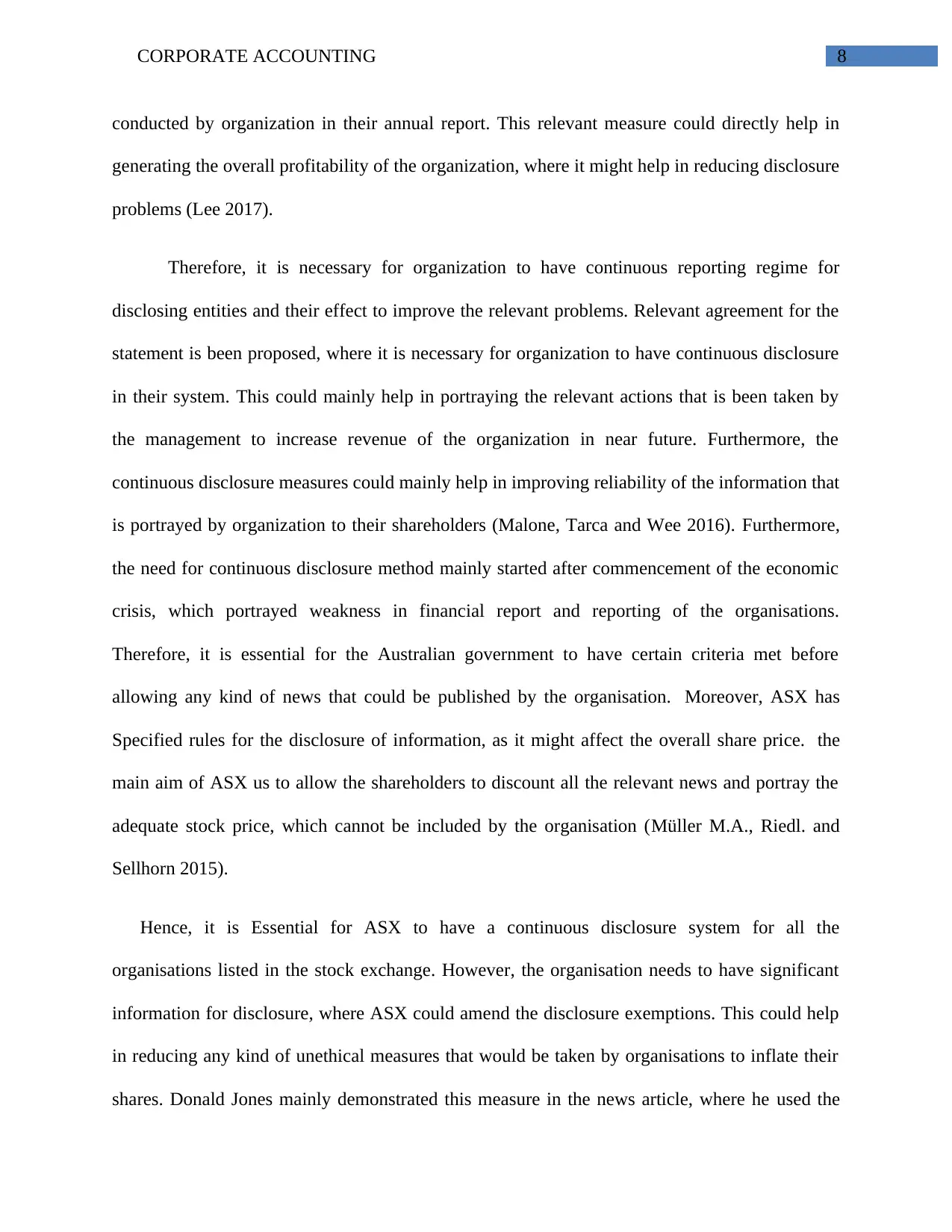
CORPORATE ACCOUNTING 8
conducted by organization in their annual report. This relevant measure could directly help in
generating the overall profitability of the organization, where it might help in reducing disclosure
problems (Lee 2017).
Therefore, it is necessary for organization to have continuous reporting regime for
disclosing entities and their effect to improve the relevant problems. Relevant agreement for the
statement is been proposed, where it is necessary for organization to have continuous disclosure
in their system. This could mainly help in portraying the relevant actions that is been taken by
the management to increase revenue of the organization in near future. Furthermore, the
continuous disclosure measures could mainly help in improving reliability of the information that
is portrayed by organization to their shareholders (Malone, Tarca and Wee 2016). Furthermore,
the need for continuous disclosure method mainly started after commencement of the economic
crisis, which portrayed weakness in financial report and reporting of the organisations.
Therefore, it is essential for the Australian government to have certain criteria met before
allowing any kind of news that could be published by the organisation. Moreover, ASX has
Specified rules for the disclosure of information, as it might affect the overall share price. the
main aim of ASX us to allow the shareholders to discount all the relevant news and portray the
adequate stock price, which cannot be included by the organisation (Müller M.A., Riedl. and
Sellhorn 2015).
Hence, it is Essential for ASX to have a continuous disclosure system for all the
organisations listed in the stock exchange. However, the organisation needs to have significant
information for disclosure, where ASX could amend the disclosure exemptions. This could help
in reducing any kind of unethical measures that would be taken by organisations to inflate their
shares. Donald Jones mainly demonstrated this measure in the news article, where he used the
conducted by organization in their annual report. This relevant measure could directly help in
generating the overall profitability of the organization, where it might help in reducing disclosure
problems (Lee 2017).
Therefore, it is necessary for organization to have continuous reporting regime for
disclosing entities and their effect to improve the relevant problems. Relevant agreement for the
statement is been proposed, where it is necessary for organization to have continuous disclosure
in their system. This could mainly help in portraying the relevant actions that is been taken by
the management to increase revenue of the organization in near future. Furthermore, the
continuous disclosure measures could mainly help in improving reliability of the information that
is portrayed by organization to their shareholders (Malone, Tarca and Wee 2016). Furthermore,
the need for continuous disclosure method mainly started after commencement of the economic
crisis, which portrayed weakness in financial report and reporting of the organisations.
Therefore, it is essential for the Australian government to have certain criteria met before
allowing any kind of news that could be published by the organisation. Moreover, ASX has
Specified rules for the disclosure of information, as it might affect the overall share price. the
main aim of ASX us to allow the shareholders to discount all the relevant news and portray the
adequate stock price, which cannot be included by the organisation (Müller M.A., Riedl. and
Sellhorn 2015).
Hence, it is Essential for ASX to have a continuous disclosure system for all the
organisations listed in the stock exchange. However, the organisation needs to have significant
information for disclosure, where ASX could amend the disclosure exemptions. This could help
in reducing any kind of unethical measures that would be taken by organisations to inflate their
shares. Donald Jones mainly demonstrated this measure in the news article, where he used the
⊘ This is a preview!⊘
Do you want full access?
Subscribe today to unlock all pages.

Trusted by 1+ million students worldwide
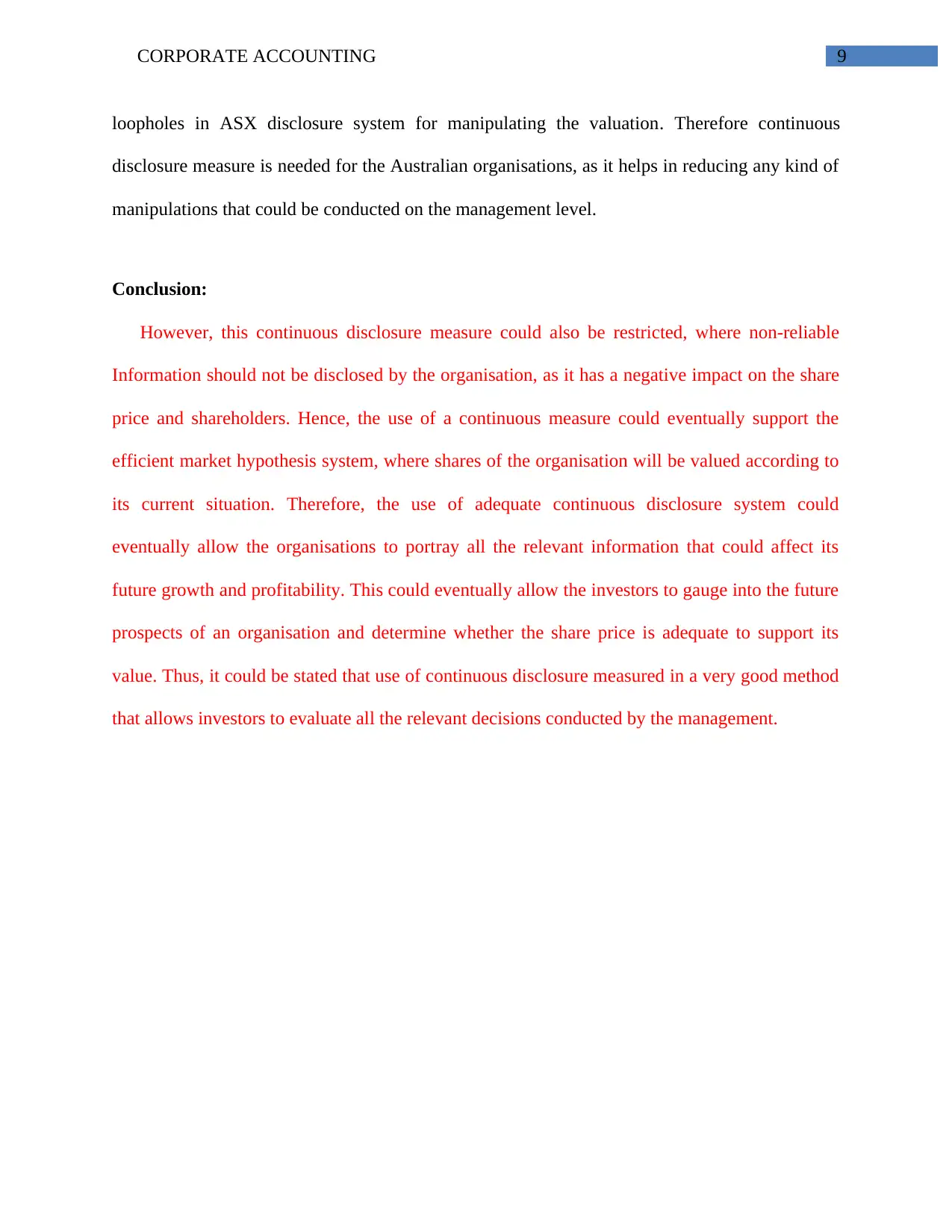
CORPORATE ACCOUNTING 9
loopholes in ASX disclosure system for manipulating the valuation. Therefore continuous
disclosure measure is needed for the Australian organisations, as it helps in reducing any kind of
manipulations that could be conducted on the management level.
Conclusion:
However, this continuous disclosure measure could also be restricted, where non-reliable
Information should not be disclosed by the organisation, as it has a negative impact on the share
price and shareholders. Hence, the use of a continuous measure could eventually support the
efficient market hypothesis system, where shares of the organisation will be valued according to
its current situation. Therefore, the use of adequate continuous disclosure system could
eventually allow the organisations to portray all the relevant information that could affect its
future growth and profitability. This could eventually allow the investors to gauge into the future
prospects of an organisation and determine whether the share price is adequate to support its
value. Thus, it could be stated that use of continuous disclosure measured in a very good method
that allows investors to evaluate all the relevant decisions conducted by the management.
loopholes in ASX disclosure system for manipulating the valuation. Therefore continuous
disclosure measure is needed for the Australian organisations, as it helps in reducing any kind of
manipulations that could be conducted on the management level.
Conclusion:
However, this continuous disclosure measure could also be restricted, where non-reliable
Information should not be disclosed by the organisation, as it has a negative impact on the share
price and shareholders. Hence, the use of a continuous measure could eventually support the
efficient market hypothesis system, where shares of the organisation will be valued according to
its current situation. Therefore, the use of adequate continuous disclosure system could
eventually allow the organisations to portray all the relevant information that could affect its
future growth and profitability. This could eventually allow the investors to gauge into the future
prospects of an organisation and determine whether the share price is adequate to support its
value. Thus, it could be stated that use of continuous disclosure measured in a very good method
that allows investors to evaluate all the relevant decisions conducted by the management.
Paraphrase This Document
Need a fresh take? Get an instant paraphrase of this document with our AI Paraphraser
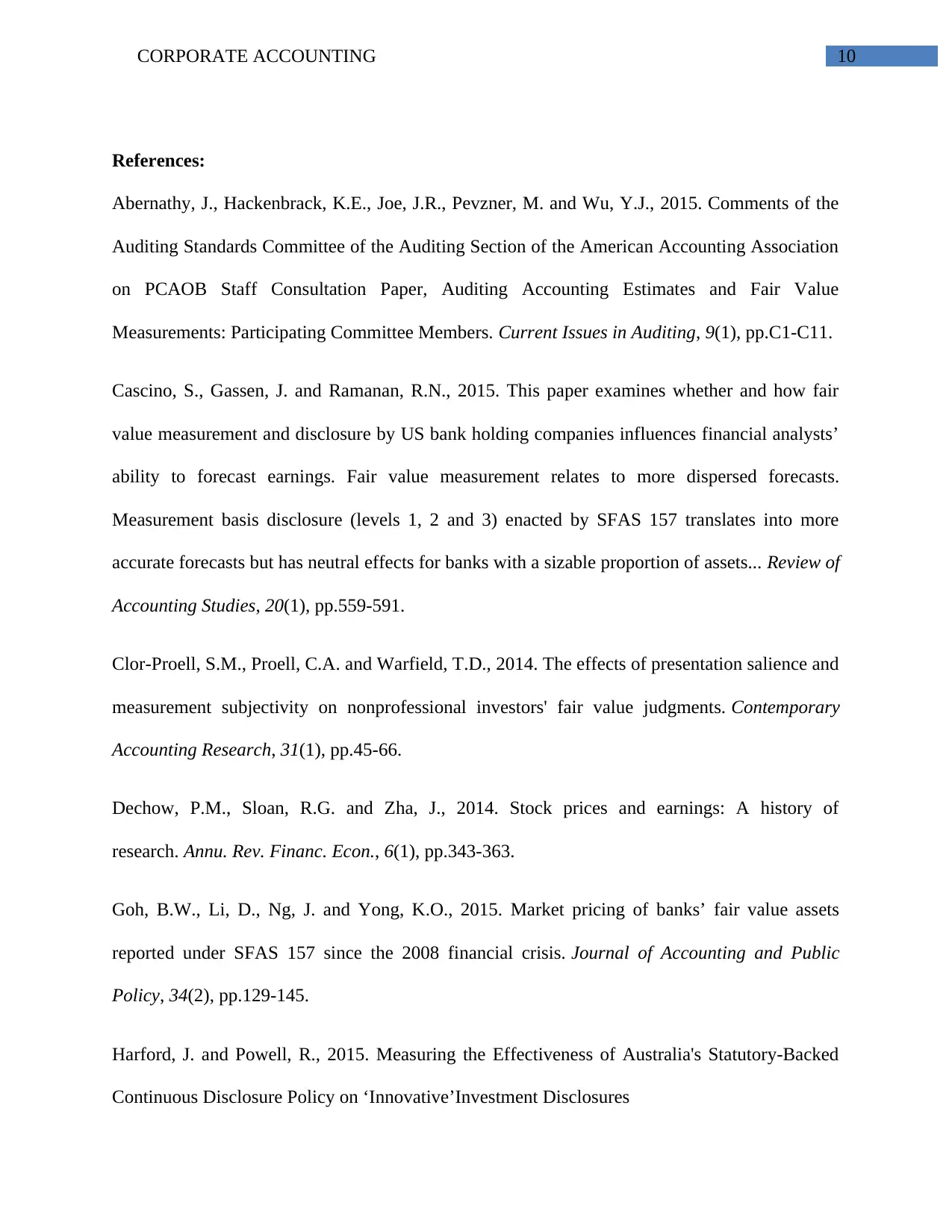
CORPORATE ACCOUNTING 10
References:
Abernathy, J., Hackenbrack, K.E., Joe, J.R., Pevzner, M. and Wu, Y.J., 2015. Comments of the
Auditing Standards Committee of the Auditing Section of the American Accounting Association
on PCAOB Staff Consultation Paper, Auditing Accounting Estimates and Fair Value
Measurements: Participating Committee Members. Current Issues in Auditing, 9(1), pp.C1-C11.
Cascino, S., Gassen, J. and Ramanan, R.N., 2015. This paper examines whether and how fair
value measurement and disclosure by US bank holding companies influences financial analysts’
ability to forecast earnings. Fair value measurement relates to more dispersed forecasts.
Measurement basis disclosure (levels 1, 2 and 3) enacted by SFAS 157 translates into more
accurate forecasts but has neutral effects for banks with a sizable proportion of assets... Review of
Accounting Studies, 20(1), pp.559-591.
Clor‐Proell, S.M., Proell, C.A. and Warfield, T.D., 2014. The effects of presentation salience and
measurement subjectivity on nonprofessional investors' fair value judgments. Contemporary
Accounting Research, 31(1), pp.45-66.
Dechow, P.M., Sloan, R.G. and Zha, J., 2014. Stock prices and earnings: A history of
research. Annu. Rev. Financ. Econ., 6(1), pp.343-363.
Goh, B.W., Li, D., Ng, J. and Yong, K.O., 2015. Market pricing of banks’ fair value assets
reported under SFAS 157 since the 2008 financial crisis. Journal of Accounting and Public
Policy, 34(2), pp.129-145.
Harford, J. and Powell, R., 2015. Measuring the Effectiveness of Australia's Statutory-Backed
Continuous Disclosure Policy on ‘Innovative’Investment Disclosures
References:
Abernathy, J., Hackenbrack, K.E., Joe, J.R., Pevzner, M. and Wu, Y.J., 2015. Comments of the
Auditing Standards Committee of the Auditing Section of the American Accounting Association
on PCAOB Staff Consultation Paper, Auditing Accounting Estimates and Fair Value
Measurements: Participating Committee Members. Current Issues in Auditing, 9(1), pp.C1-C11.
Cascino, S., Gassen, J. and Ramanan, R.N., 2015. This paper examines whether and how fair
value measurement and disclosure by US bank holding companies influences financial analysts’
ability to forecast earnings. Fair value measurement relates to more dispersed forecasts.
Measurement basis disclosure (levels 1, 2 and 3) enacted by SFAS 157 translates into more
accurate forecasts but has neutral effects for banks with a sizable proportion of assets... Review of
Accounting Studies, 20(1), pp.559-591.
Clor‐Proell, S.M., Proell, C.A. and Warfield, T.D., 2014. The effects of presentation salience and
measurement subjectivity on nonprofessional investors' fair value judgments. Contemporary
Accounting Research, 31(1), pp.45-66.
Dechow, P.M., Sloan, R.G. and Zha, J., 2014. Stock prices and earnings: A history of
research. Annu. Rev. Financ. Econ., 6(1), pp.343-363.
Goh, B.W., Li, D., Ng, J. and Yong, K.O., 2015. Market pricing of banks’ fair value assets
reported under SFAS 157 since the 2008 financial crisis. Journal of Accounting and Public
Policy, 34(2), pp.129-145.
Harford, J. and Powell, R., 2015. Measuring the Effectiveness of Australia's Statutory-Backed
Continuous Disclosure Policy on ‘Innovative’Investment Disclosures
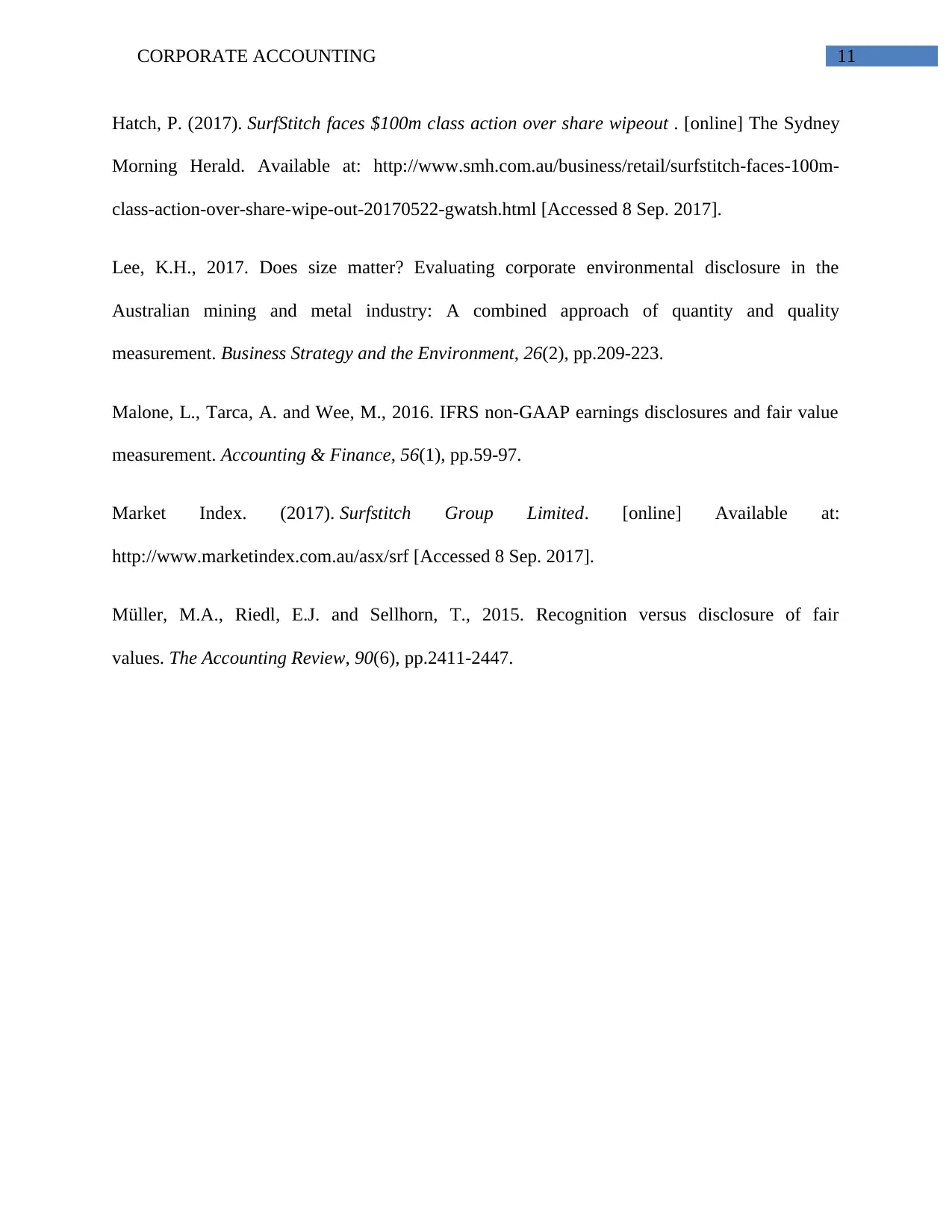
CORPORATE ACCOUNTING 11
Hatch, P. (2017). SurfStitch faces $100m class action over share wipeout . [online] The Sydney
Morning Herald. Available at: http://www.smh.com.au/business/retail/surfstitch-faces-100m-
class-action-over-share-wipe-out-20170522-gwatsh.html [Accessed 8 Sep. 2017].
Lee, K.H., 2017. Does size matter? Evaluating corporate environmental disclosure in the
Australian mining and metal industry: A combined approach of quantity and quality
measurement. Business Strategy and the Environment, 26(2), pp.209-223.
Malone, L., Tarca, A. and Wee, M., 2016. IFRS non‐GAAP earnings disclosures and fair value
measurement. Accounting & Finance, 56(1), pp.59-97.
Market Index. (2017). Surfstitch Group Limited. [online] Available at:
http://www.marketindex.com.au/asx/srf [Accessed 8 Sep. 2017].
Müller, M.A., Riedl, E.J. and Sellhorn, T., 2015. Recognition versus disclosure of fair
values. The Accounting Review, 90(6), pp.2411-2447.
Hatch, P. (2017). SurfStitch faces $100m class action over share wipeout . [online] The Sydney
Morning Herald. Available at: http://www.smh.com.au/business/retail/surfstitch-faces-100m-
class-action-over-share-wipe-out-20170522-gwatsh.html [Accessed 8 Sep. 2017].
Lee, K.H., 2017. Does size matter? Evaluating corporate environmental disclosure in the
Australian mining and metal industry: A combined approach of quantity and quality
measurement. Business Strategy and the Environment, 26(2), pp.209-223.
Malone, L., Tarca, A. and Wee, M., 2016. IFRS non‐GAAP earnings disclosures and fair value
measurement. Accounting & Finance, 56(1), pp.59-97.
Market Index. (2017). Surfstitch Group Limited. [online] Available at:
http://www.marketindex.com.au/asx/srf [Accessed 8 Sep. 2017].
Müller, M.A., Riedl, E.J. and Sellhorn, T., 2015. Recognition versus disclosure of fair
values. The Accounting Review, 90(6), pp.2411-2447.
⊘ This is a preview!⊘
Do you want full access?
Subscribe today to unlock all pages.

Trusted by 1+ million students worldwide
1 out of 12
Related Documents
Your All-in-One AI-Powered Toolkit for Academic Success.
+13062052269
info@desklib.com
Available 24*7 on WhatsApp / Email
![[object Object]](/_next/static/media/star-bottom.7253800d.svg)
Unlock your academic potential
Copyright © 2020–2025 A2Z Services. All Rights Reserved. Developed and managed by ZUCOL.





